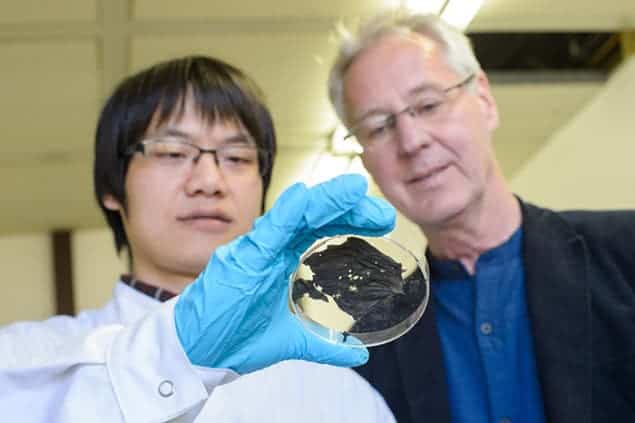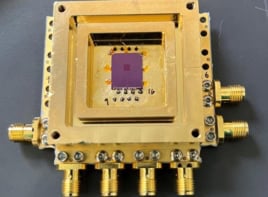Flash Physics is our daily pick of the latest need-to-know developments from the global physics community selected by Physics World‘s team of editors and reporters

Superconducting fabric is ultrathin, flexible and lightweight
A flexible fabric woven from plastic fibres and high-temperature superconductor nanowires has been unveiled by Uwe Hartmann, Volker Presser and colleagues at the University of Saarland in Germany. Potential applications of the material include coatings that screen objects form electromagnetic fields, flexible resistance-free electrical cables and friction-free motion through magnetic levitation. The material, which looks like charred paper, is a superconductor below about 73 K. However, unlike most other high-temperature superconductors – which are ceramics – the fabric is as flexible as plastic kitchen film. It has a density of just 0.05 g/cm3, which is just 1% of most supercomputing materials. “This makes the material very promising for all those applications where weight is an issue, such as in space technology,” says Hartmann, adding: “There are also potential applications in medical technology.” The superconducting nanowires are 300 nm or less in diameter and are made from yttrium-barium-copper-oxide or a similar material. The nanowire manufacturing process is described in Superconductor Science and Technology and the new material will be presented at the Hannover Messe industrial fair on 24–28 April.
Girls underestimate their mathematical ability, reveals study

A study by psychologists in the US has found that high-school girls rate their competence in mathematics lower than boys, even for those with similar abilities, according to research reported in Frontiers in Psychology. Carried out by Lara Perez-Felkner at Florida State University and colleagues, the study asked high-school students in the 10th and 12th grade to indicate their level of agreement to statements such as “I am certain I can understand the most difficult material presented in math texts”. For boys and girls who showed a high ability in mathematics, the researchers found that boys rated their ability 27% higher than girls. The authors say that this difference could explain why more boys go on to study mathematics and science at degree level and beyond. “The argument continues to be made that gender differences in the hard sciences is all about ability,” says Perez-Felkner. “But when we hold tests scores constant, we see boys still rate their ability higher, and girls rate their ability lower.” The authors suggest that initiatives such as regular science camps, extracurricular activity in science and increased access to female scientists could help to boost girls’ confidence in mathematics and science.
Super-Earth exoplanet has atmosphere

An atmosphere has been detected on an exoplanet that is slightly larger than Earth. Previous observations of atmospheres on planets outside the solar system have involved objects much more massive than Earth. But this is the first time an atmosphere has been detected on a planet only marginally bigger than ours – 1.6 times the mass of Earth and 1.4 times the radius. The planet in question, GJ 1132b, orbits a red-dwarf star 39 light-years away and is classified as a super-Earth because it is bigger than Earth but smaller than a gas giant. A European collaboration used the GROND imager at the MPG/ESO 2.2 m telescope of the European Southern Observatory in Chile to image the changing brightness of GJ 1132b’s host star as the planet passed in front of it. By looking at seven different wavelengths, the team saw that the planet appeared bigger when observed in the infrared. This suggests that GJ 1132b has an atmosphere that is opaque to infrared but transparent to other wavelengths. Using simulations, the researchers suggest this is because the atmosphere may be rich in oxygen and methane, but with the current data it is not possible to say how similar or dissimilar GJ 1132b is to Earth. It may be a water planet with a steam atmosphere, for example. Meanwhile, as the current method for detecting life on other planets is to look for fingerprint chemical imbalances in their atmospheres, the finding, published in the Astronomical Journal, is a step towards finding life outside the solar system.
- You can find all our daily Flash Physics posts in the website’s news section, as well as on Twitter and Facebook using #FlashPhysics. Tune in to physicsworld.com later today to read today’s extensive news story on Belle correlations between 500,000 atoms.



